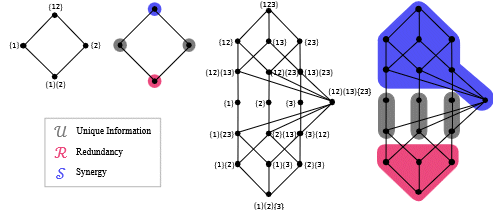PIRD – Partial Information Rate Decomposition
A
Framework for the application of the principles of Partial Information
Decomposition to random processes with temporal statistical structure
Partial Information Decomposition (PID) is a principled and flexible
method to unveil complex high-order interactions in multi-unit network
systems. Though being defined exclusively for random variables, PID is
ubiquitously applied to multivariate time series taken as realizations
of random processes with temporal statistical structure. To overcome
the incorrect depiction of high-order effects by PID schemes applied to
dynamic networks, we introduce the framework of Partial Information
Rate Decomposition (PIRD). PIRD is formalized applying lattice theory
to decompose the information shared dynamically between a target random
process and a set of source processes, and implemented for Gaussian
processes through a spectral expansion of information rates. It is then
demonstrated in practice analyzing time series from large-scale climate
oscillations [Faes et al., 2025] as well as from a physiological
network comprising cerebrovascular and cardiovascular variables
[Sparacino et al., 2025].

The toolbox realizes PIRD for a network of random processes mapped by multivariate time series, for the case of two target process and two or three source processes. The practical implementation is based on fitting a vector autoregressive (VAR) model on the set of (three or four) analyzed time series, and then computing spectral measures of mutual information rate (MIR) between the target and (groups of) sources from the frequency domain representation of the VAR parameters; the spectral MIR functions are then used to compute spectral redundancy rate, from which the PID principle is applied in both frequency and time domains to identify unique, redundant and synergistic rates of information shared between target and sources. In the complete implementation [Sparacino et al., 2025] (folder \full\), the VAR analysis is performed (both for the cases of two and three sources) directly in the frequency domain to obtain information decomposition at each specific frequency. In the implementation used for the letter [Faes et al., 2025] (folder \statespace\), VAR analysis is performed (only for the case of two sources) using state space models for the spectral representation and the spectral redundancy rate is integrated to get time-domain measures, so that the PIRD is executed in the time-domain only. The two implementations are compared on representative climate data in the script climate_data.mat.
The “Full” framework is demonstrated in the scripts simu_freqPIRD.m and appl_climate_data.m to demonstrate the framework in simulation 3 and in the climate data application of [Sparacino et al., 2025]
The “State space” framework is demonstrated in the scripts simuLETTER1.m and simuLETTER2.m to demonstrate the framework in the simulations of [Faes et al., 2025]
DOWNLOAD: Zip file with all scripts and functions: PIRD.zip
The code is provided free of charge. It is neither exhaustively tested
nor particularly well documented. The authors accept no liability for
its use. Use, modification and redistribution of the code is allowed in
any way users see fit. Authors ask only that authorship is acknowledged
and ref. [1] is cited upon utilization of the code in integral or
partial form.
DISCLAIMER OF
WARRANTIES AND LIMITATION OF LIABILITY The code is supplied as is and
all use is at your own risk. The authors disclaim all warranties of any
kind, either express or implied, as to the softwares, including, but
not limited to, implied warranties of fitness for a particular purpose,
merchantability or non - infringement of proprietary rights. Neither
this agreement nor any documentation furnished under it is intended to
express or imply any warranty that the operation of the software will
be error - free. Under no circumstances shall the authors of the
softwares provided here be liable to any user for direct, indirect,
incidental, consequential, special, or exemplary damages, arising from
the software, or user' s use or misuse of the softwares. Such
limitation of liability shall apply whether the damages arise from the
use or misuse of the data provided or errors of the software.
References:
[Faes et al., 2025] - L Faes, L Sparacino, G Mijatovic, Y Antonacci, L Ricci, D Marinazzo, S Stramaglia, 'Partial Information Rate Decomposition', arXiV preprint, 2025; DOI:
[Sparacino et al., 2025] - L Sparacino, G Mijatovic, Y Antonacci, L Ricci, D Marinazzo, S Stramaglia, L Faes, 'Decomposing Multivariate Information Rates in Networks of Random Processes', arXiV preprint, 2025; DOI: